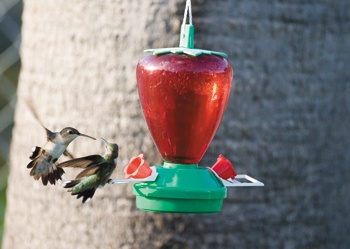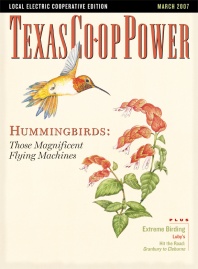Before 7 on a September morning, a crowd has already gathered in a Rockport suburban driveway to watch Bob and Martha Sargent of Clay, Alabama, band ruby-throated hummingbirds. Tens of thousands of the miniscule birds stop for a few days along the Texas Gulf Coast to stoke up on nectar and protein before making their journey to Mexico for the winter. In fact, this annual staging has been called “one of Texas’ most amazing avian spectacles.”
The visit of the ruby-throats is one of the most popular events in the Rockport-Fulton area, which is north of Corpus Christi. Last year marked the 18th year of the Hummer/Bird Celebration. Thousands of hummingbird enthusiasts, as well as experts and the merely curious, were on hand for three days of yard tours, lectures and a trade show with feeders, bird memorabilia and nectar plants.
Nothing is more popular than the banding demonstrations, where you can see the tiny marvels up close and perhaps hold one in your hand. The birds, with their characteristic ruby throats and iridescent green caps, are captured at a backyard feeder and placed in string bags. Volunteers in brightly colored T-shirts bring the little bags to the Sargents’ table. Some birds flutter energetically inside the nets, and others take the opportunity to rest.
Bob selects one of the tiny birds, which average 3.5 grams (roughly the weight of two pennies), in his huge fist and ever so delicately attaches an aluminum alloy band to one leg. The band is about the size of Franklin D. Roosevelt’s ear on a dime. He weighs the bird, which lies passively in his hand, and tells Martha how many grams to record. With a tiny straw, he blows apart the feathers on the bird’s belly to detect how much fat he or she has accumulated. Some experts say the birds can burn as much as 2 grams of fat a day flying across the Gulf of Mexico. They are usually ready to continue their journey when they weigh in at 4 to 4.5 grams. Some swell up to little flying basketballs at 6 or even 6.5 grams.
Once the Sargents have noted the sex of the bird (the females have more subdued colors in addition to different wing and tail structures), measured wingspan and tail in millimeters, and noted striations in a bird’s bill (young ones have the most striations), Bob places the bird in the palm of a bystander’s hand to hold until it flits away. One can feel the little heart pumping away at 600 beats or more per minute.
Banding research indicates ruby-throated hummingbirds travel from the north and the east, where they mate during the warm season. The birds spend their summers as far north as Canada or as far south as Texas. Like most hummingbirds, the rubys usually have two nests a season. The male impregnates a female and abandons her, sometimes to impregnate another soon-to-be single mother. The females valiantly raise two to three clutches of eggs a season.
Argumentative and territorial, most hummingbirds are loners even during migration. They don’t congregate in the same area for companionship but because they are attracted to the same habitat. Ruby-throats gather along the Gulf Coast near Rockport to feed voraciously. Other birds stop farther south in the Brownsville area. From there, the ruby-throats may cross the Gulf to central or southern Mexico or Panama. Most of the birds will circumnavigate the Gulf in the fall because of strong headwinds. However, in the spring, ruby-throats have been observed crossing up to 600 miles of open water with the help of prevailing winds.
Migration, mating habits and habitat are just three of the topics on which banders and other birders are trying to shed light. The Hummer/Bird Study Group founded by the Sargents has reports of banded birds in Georgia, North Carolina and Connecticut, just to name a few states. The organization has banding stations in Alabama, Mississippi, Texas and West Virginia.
The Sargents and other members of the Hummer/Bird Study Group make a point of attending the Rockport event. Texas, after all, is at the mouth of a funnel the hummingbirds traverse to get to Mexico for the winter. And the state is one of the hot spots of research on hummingbirds, thanks to the Texas Hummingbird Roundup, a citizen-science survey sponsored by the Texas Parks and Wildlife Department (TPWD). Since 1994, TPWD has kept a database and tracked trends using information from hummingbird sightings. The most recent push has been to find volunteers to participate in the roundup in the hummingbird-rich Trans-Pecos Region of West Texas and the Upper Rio Grande Valley. Texas is known to host 18 species of hummingbirds—more than any other state. Any resident should be able to sight at least two species in his or her home territory.
About 10 hummingbird species have been identified around Rockport-Fulton. The adjacent towns are situated on a peninsula covered with picturesque live oaks turned inland away from the salt spray. Two jewel-like bays, Aransas to the southeast and Copano to the northwest, are sheltered from the Gulf by San José Island, just north of Padre Island National Seashore. The habitat attracts ruby-throats like Tahiti attracts tourists. And townsfolk have made it easy and fun to observe the huge congregations of birds and birdwatchers.
After watching the banding and seeing the diminutive birds up close, it is time to go yard to yard and see how area residents design their hummingbird gardens. Last year, 23 locations were on the Rockport-Fulton Hummer Homes map. Bus tours were available for $10 a person, or visitors could pick up a map at the Rockport-Fulton High School auditorium and strike out on their own.
The best times for viewing are just after sunrise or just before sunset when the birds are breaking their fast or preparing for the night’s deep slumber. Sometimes the birds drink so much before bed, the throat area starts to swell.
At various stops, a photographer and I met people from as far away as Michigan and Georgia as well as members of the Houston Innerloop Photo Club and of a Good Sam’s RV club. We gathered quietly by chain-link fences, tiptoed into backyards, lounged in lawn chairs and generally took full advantage of Rockport-Fulton hospitality. Occasionally word would spread that someone had spotted a rufous hummingbird or maybe even a buff-bellied hummingbird across town, and there would be an exodus to the site.
The ruby-throats begin arriving in late July or August. A couple weeks before the festival, hummingbirders bring out massive numbers of feeders and refill them several times a day to attract the largest possible number of migrants. The birds flit about, squabbling, feeding and putting on a great show. Their incessant activity is enough to jangle one’s nerves.
Or not. There’s no predicting which yards the hummingbirds are going to prefer at a particular time of day. In addition to homes in town, the Fennessey Ranch between Refugio and Sinton makes a 9-mile hummingbird habitat tour available for visitors during the celebration. (TPWD encourages ranches to open their gates to wildlife viewing.)
All of the residences on the hummingbird tour cultivate natural habitat for providing shelter, water and nectar (see sidebar). Except for providing for the birds’ basic needs, the homes on the tour vary from immaculately groomed estates with pools backing up to a golf course to a TPWD-certified wildscape such as Birdsong. At the latter you can sit on the porch with Beth Hester and Petra Villegas and look through scrapbooks showing how many years it has taken for their modest lot revert to a wilderness. The women are somewhat bemused by the fact that Birdsong is now a Rockport-Fulton landmark, considering they had to fight city hall to get permission for their property to grow wild. Visitors appreciatively grab bottled water from a chest on the porch and then walk the narrow trails through dense stands of sunflowers and other natural attractions.
I particularly admire the Krenek Home, a heavily wooded homesite of several acres with boardwalks that can take you from grazing land through dense scrub oak past a commodious two-story house then over indigenous grasses to a high overlook of Copano Bay. A much less elaborate compound of the Norcross Home has a chain-link fenced front yard of St. Augustine grass dotted with a couple of palm trees and multitudinous feeders shaped like strawberries. It was so simple yet whimsical we dubbed it “Strawberry Fields.”
The 2007 Hummer/Bird Celebration will be held September 13-16. For information, call the Rockport-Fulton Chamber of Commerce at 1-800-826-6441.
For more information about the Texas Hummingbird Roundup visit www.tpwd.state.tx.us or write Texas Parks and Wildlife Department, Attn: Texas Hummingbird Roundup, 4200 Smith School Rd., Austin, TX 78744.
Kaye Northcott is editor of Texas Co-op Power.
Ave Bonar is a Texas photographer best known for her documentary work.


